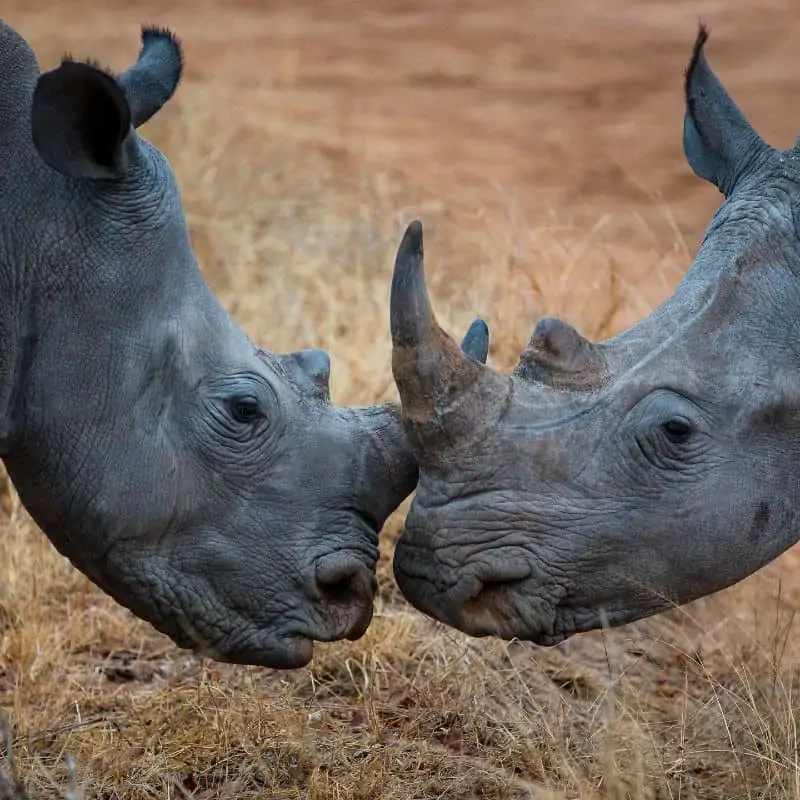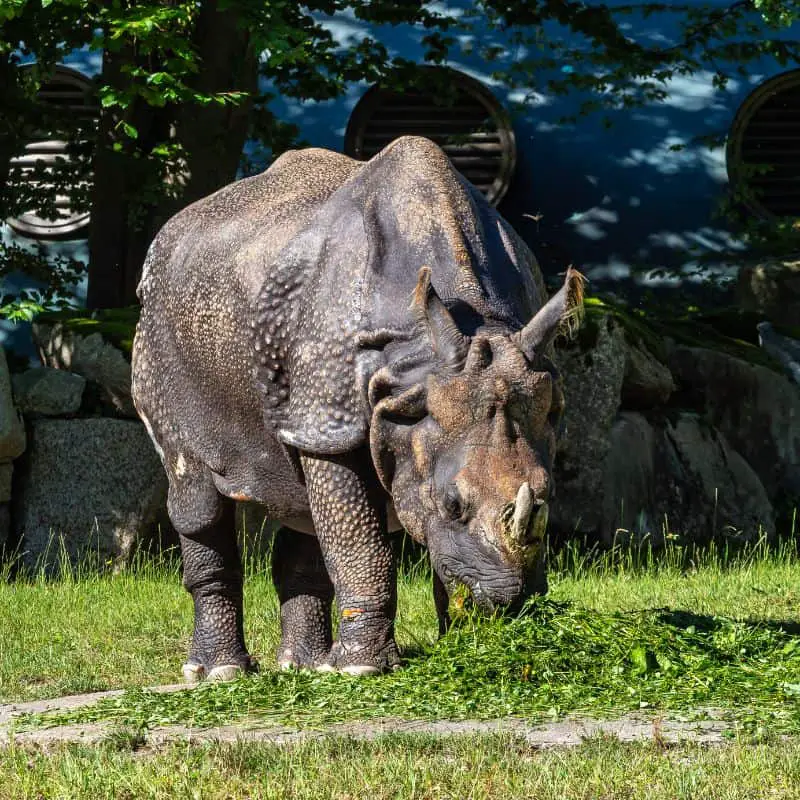The rhinoceros (rhino) is a mammal that dates back millions of years. These animals are easily recognized by their prehistoric features and the horns on their forehead.
They are massive and stocky (weighing 1,320 to 7,716 pounds) and are the second largest mammal after the elephant. Despite their huge size, rhinos can run very fast and reach speeds of 25 to 34 mph. But how long do rhinos live?
Rhinos can live, on average, between 35 to 40 years in the wild. But their life expectancy is much lower due to them being hunted and killed for their horns. Rhinos living in protected sanctuaries and game reserves can live up to 45 years, sometimes longer.
The rhino’s lifespan from birth to adulthood is slow and steady as these majestic animals spend their days grazing on the vegetation, cooling off in the mud, and sleeping during the hottest times of the day.
The Rhino’s Lifespan
Five species of rhino exist in the world.
There are Africa’s black and white rhino and the three Asian species: the greater one-horned rhino (Indian Rhino), the Sumatran, and the Javan rhino.
The White Rhino’s Lifespan
This rhino is the largest and can live 35 years in the wild. The rhino is grey and is also known as the “square-lipped” rhino.
Despite being semi-social and territorial, they can live in captivity for up to 40 years.
However, the oldest known white rhino was Toby, who reached the age of 54 when he died in a zoo in Northern Italy.

The Black Rhino’s Lifespan
Black Rhinos are also grey and are smaller than white rhinos, and have hooked upper lips. The black rhino can live between 35 and 40 years in the wild and captivity.
Females are more sociable than males, who, in the wild, are solitary animals.
In captivity, a female named Fausta was the oldest black rhino who died at the age of 57 in Tanzania.
The Greater One-Horned Rhino’s Lifespan
These are the second-largest rhino species and the largest of the Asian species. These rhinos are grey and have a single black horn.
They live 30 to 40 years in the wild, and four of these rhinos have lived for over 45 years, the oldest being 47.
The Sumatran Rhino’s Lifespan
These rhinos are the smallest of the Asian rhino and the only Asian rhino to have two horns. Their horns are much smaller than the African rhinos.
A Sumatran rhino’s hide is dark red-brown and is covered with patches of stiff, short, dark hair. Although these animals do live in captivity, they do not breed well.
They live between 35 to 40 years.
The Javan Rhino’s Lifespan
These rhinos are only found in Indonesia’s Ujung Kulon National Park. They are the rarest mammal on earth.
They are dusky grey and look much like the greater one-horned rhino, only slightly smaller.
Their average lifespan is unknown but would probably be between 35 to 40 years, like the other rhinos. No Javan rhinos are living in captivity.
What Affects The Lifespan of Rhinos?
Although the lifespan of a rhino living in the wild is between 35 and 40 years, many are not expected to reach this milestone.
They are being hunted by predators, with young rhinos falling prey to predators like wild dogs, hyenas, lions, and crocodiles.
But the biggest predator is man, who hunts and kills the rhino for their horns.

Rhinos Are Killed For Their Horns
One of the main reasons why rhinos do not reach their potential age in the wild is because they are being hunted and killed by man.
The African Rhinos, the Black and the White Rhino, are being poached for their horns.
Poachers are becoming increasingly sophisticated and use helicopters to track the rhinos. Once the animals are shot with guns or tranquilizing darts, the horns are removed using chainsaws. The horns are airlifted away and sold illegally. The rhino is already dead, or the animal will bleed to death.
Ground rhino horn is used in Asia as a medicinal cure for various ailments. In Vietnam, it is seen as a status symbol.
Over the last ten years, over 7,100 African rhinos have been killed by poaching. On 31 December 2021 and according to the ICUN’s African and Asian Rhino Specialist Group, the rhino population was only 26,272.
The black rhino is critically endangered, and in 2021, less than 5,500 of these animals remain. Due to protection and management, white rhino numbers have increased slightly and are now on the near-threatened list. About 18,000 white rhinos now live in protected areas and private game reserves.
Of all the rhino species, the Sumatran rhino is the most threatened. Less than 80 of these rhinos still survive in small fragmented populations across Indonesia on the islands of Borneo and Sumatra.
Although there are only 67 Javan rhinos still living in one site, they are a healthy breeding population. But Javan rhinos are still a critically endangered rhino species.
The greater one-horned rhino has been the most successful in conservation, and they have a healthy population of 3,700. This recovery is significant because only 200 of these rhinos were still living at the beginning of the 20th century.

However, they are still threatened by poaching for their horns. The Word Wildlife Fund (WWF) continues to work with the Nepalese and Indian governments to help with this threat.
In Africa, the rhinos are protected in large sanctuaries. In national parks, specially trained rangers and scouts watch over these animals. Removing the rhino’s horns is another conservation attempt to save these animals.
South Africa is home to 72% of the rhino population. Even though the best attempts are being made to ensure their safety, the rhino hunting for their horns continues.
Loss Of Natural Habitat
Loss of natural habitat is another major threat to the rhino. The spaces where rhinos thrive are being taken over by agriculture and human settlements.
Rhinos require a large space in which to roam and feed. With the loss of habitat, rhinos are being split into smaller groups. They are becoming isolated, which is having an impact on breeding.
Because rhinos live in isolated areas, they are prone to inbreeding, as healthy genetic mixing is more difficult among smaller groups.
Sometimes the breeding is depressed because of the lack of resources, and disease can spread rapidly through highly concentrated rhino populations.
Helping Rhinos To Live Longer
Organizations like the WWF and other friends of the rhino are working tirelessly to establish new rhino populations.
They move rhinos from nature parks where there are too many rhinos in a concentrated area to parks with more space to accommodate them.
They also help to educate the communities based around these conservation parks about the importance of rhino habitats.
In Africa and other regions where the rhino is found are working to improve international and local laws to stop the illegal trade and selling of rhino horns. Preventing the poaching of rhinos is detrimental to keeping the rhino alive and from going extinct.
Many preventative measures are being put in place by private reserve owners and conservationists to protect the rhinos from poachers.
The WWF works closely with government agencies in the U.S and worldwide and with international and local non-governmental organizations supporting rhino conservation.
Final Thoughts On How Long Rhinos Live
Rhinos living in the wild are susceptible to poachers who hunt them for their horns.
These large animals can live between 35 to 45 years in sanctuaries and protected game reserves.
The rhino population is on the decline, and the white and black rhinos in Africa, are being mercilessly hunted.
Even though measures are put in place to try and combat this ruthless slaughtering, poaching continues.
